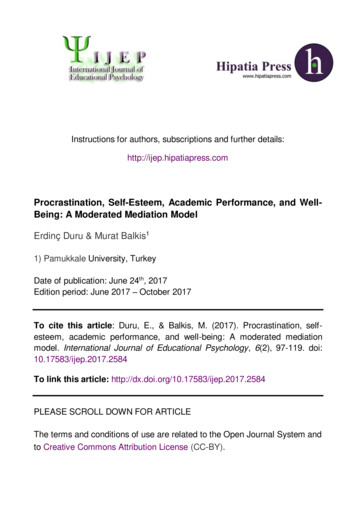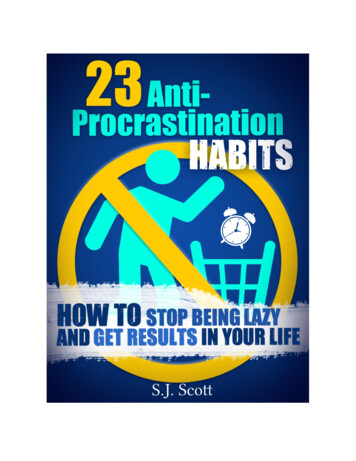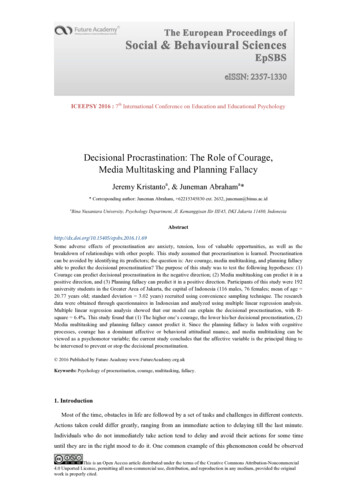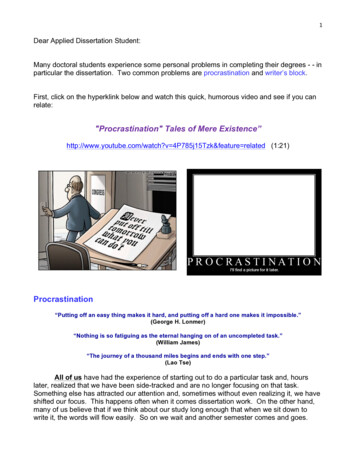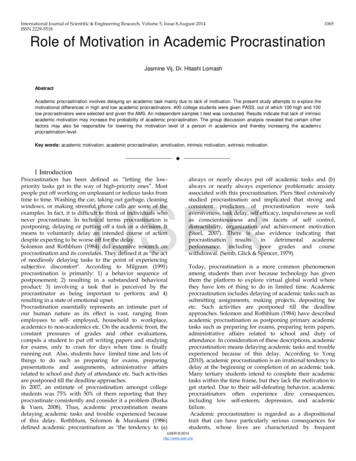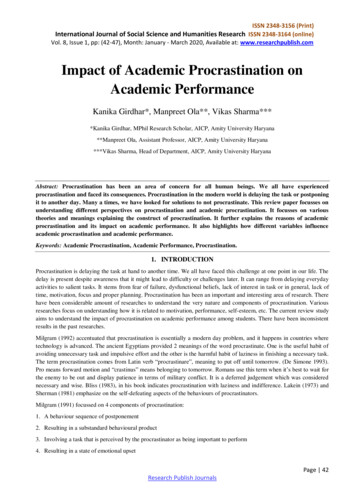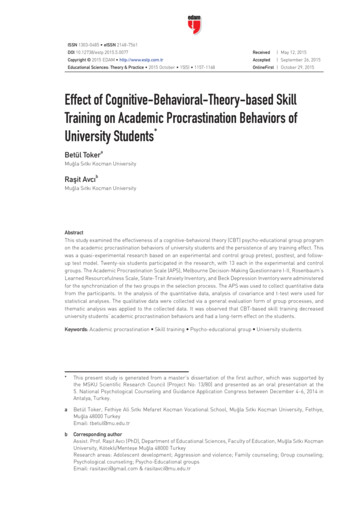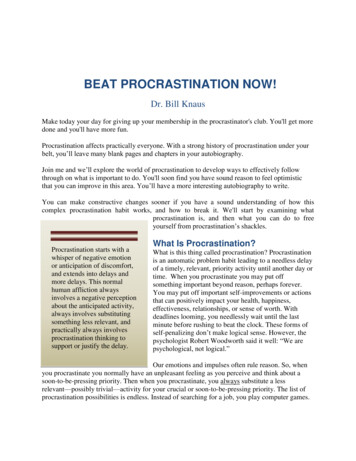
Transcription
BEAT PROCRASTINATION NOW!Dr. Bill KnausMake today your day for giving up your membership in the procrastinator's club. You'll get moredone and you'll have more fun.Procrastination affects practically everyone. With a strong history of procrastination under yourbelt, you’ll leave many blank pages and chapters in your autobiography.Join me and we’ll explore the world of procrastination to develop ways to effectively followthrough on what is important to do. You'll soon find you have sound reason to feel optimisticthat you can improve in this area. You’ll have a more interesting autobiography to write.You can make constructive changes sooner if you have a sound understanding of how thiscomplex procrastination habit works, and how to break it. We'll start by examining whatprocrastination is, and then what you can do to freeyourself from procrastination’s shackles.Procrastination starts with awhisper of negative emotionor anticipation of discomfort,and extends into delays andmore delays. This normalhuman affliction alwaysinvolves a negative perceptionabout the anticipated activity,always involves substitutingsomething less relevant, andpractically always involvesprocrastination thinking tosupport or justify the delay.What Is Procrastination?What is this thing called procrastination? Procrastinationis an automatic problem habit leading to a needless delayof a timely, relevant, priority activity until another day ortime. When you procrastinate you may put offsomething important beyond reason, perhaps forever.You may put off important self-improvements or actionsthat can positively impact your health, happiness,effectiveness, relationships, or sense of worth. Withdeadlines looming, you needlessly wait until the lastminute before rushing to beat the clock. These forms ofself-penalizing don’t make logical sense. However, thepsychologist Robert Woodworth said it well: ―We arepsychological, not logical.‖Our emotions and impulses often rule reason. So, whenyou procrastinate you normally have an unpleasant feeling as you perceive and think about asoon-to-be-pressing priority. Then when you procrastinate, you always substitute a lessrelevant—possibly trivial—activity for your crucial or soon-to-be-pressing priority. The list ofprocrastination possibilities is endless. Instead of searching for a job, you play computer games.
You fritter away the hours as your housework piles up. You hide in the shadows and watch theperson you want to date walk off with another who was bold enough to ask first. You keepgaining weight and swear that you will diet and exercise someday, but not right now. Indeed, youhave something more important to do, such as going on that one last binge with ice-cream andpizza. And later you go a bigger binge as you tell yourself ―I’ll be good later.‖ (Isn’t humannature peculiar?)Clearly, a procrastination habit is a pressuring, relapsing process. By recognizing that you canprogressively master procrastination---not cure it---you have put yourself on the path to selfimprovement. Continue on that path a way further and you bring yourself closer to a sense ofconfident composure.With confident composure, you recognize that you can directly command only yourself, and youchoose to do so. You don't demand that the world change for you, and you don't need it to. Withthis softer but stronger view, you can better influence the controllable events that take placearound you. Your psychological resources and emotional drives are fully available to defuse,finesse, or directly manage conflicts. You position yourself to create an exciting autobiographywhere the pages are forged from the fires of self-efficacy where you organize, regulate, anddirect your actions to accomplish positive and possibly some great things.Track Your ProcrastinationProcrastination can be a simple default reaction to something uncomfortable. You need torespond to a pressing email message that asks you to volunteer your time for a project you haveno interest in doing. Rather than immediately decline the offer, you opt to put off disappointingthe writer. Instead of facing the problem now, youmicrowave a bowl of soup; you pull weeds from yourgarden; you research the best crab grass killers foryour lawn. You simultaneously fritter time thatMore than a simple act ofwould ordinarily go toward your other priorities.avoidance, procrastinationHere is one potential outcome. After several weeks ofinvolves a process offurther delay, you feel obliged to agree to theconnected perceptions,unwanted project.sensations, thoughts,emotions, and actions allWhat starts as a simple default reaction often playsoccurring within a personalout as an elaborate form of procrastination. Here isand social context.an example:1. You have a report that’s on your schedule todo.
2. You view the activity as boring, unpleasant, uncomfortable, threatening, or confusing.3. You magnify the onerousness of the task as you filter out the real incentives for actingnow.4. You experience an emotional or visceral reaction.5. You seamlessly shift your focus to a substitute activity such as daydreaming or reading.6. You tell yourself that you'll get to it, perhaps tomorrow. Then, when tomorrow comes,you make up another excuse.7. When under sufficient pressure, you either finish or quit.8. You swear to yourself that you'll do better next time.9. In a related circumstance, you repeat your automatic procrastination habit.The Masks of ProcrastinationProcrastination comes in different forms. We'll look at five sample styles: discomfort dodging,self-doubt, behavioral, reactance, and health procrastination. I name procrastination styles basedon the context in which they occur, their distinguishing features, their process, or their endresults.Discomfort dodging procrastination is probably the most common form of procrastination. Here,discomfort triggers an avoidance sequence. If you view the activity as threatening, boring,uncomfortable, or uncertain, and then dodge it to avoid tension or frustration, you’ve fallen intothis procrastination trap. You can train yourself to build emotional resilience by practicing followthrough skills where you allow yourself to experience tension as you act to do relevant activitiesthat you are tempted to avoid.Self-doubt procrastination can keep you mired in inhibition and fearing failure at every turn. Inthis sad cycle you procrastinate as you second-guess, hesitate, and down yourself. Members ofthis self-doubt group habitually put off challenges unless they have a guarantee for success.When laboring under an illusion that their worth is based on what they do, members of this groupfear failure more than most. To avoid failure, they avoid many successes. However, this negativeglobal self-worth is based on a fiction. It is normally based on a definition that your worthdepends upon what you think of what you do and upon what others think of what you do.Reasonable alternative definitions are possible, including one that says that the self is too
complex to fully measure, and so a simplistic definition of worth represents a counterfeit idea.Nevertheless, if you define your worth negatively (I'm stupid. Something is wrong with me.),this view can stimulate procrastination in life zones that activate such thinking. But the biggerprocrastination issue is that of putting off taking steps to overcome self-doubts.You behaviorally procrastinate when you plan, organize, and initiate actions then quitprematurely and don't gain the anticipated benefits. You can incur both a dollar and personal costby starting and not finishing. For example, you pay your money to a fitness center and then quitafter a few weeks. Research from Behavioral Economics shows that you are better off notstarting something you won't finish. Yet how are you to know what you'll finish before you start?Reactance procrastination can result from believing that you will be unfairly inconvenienced orlose a privilege. Reactance can be a normal resistance to a loss of privilege. If the governmentoutlawed the use of the automobile and ordered you to use public transportation to save fuel, youmight be up in arms. You might agree with the need to save natural resources but at the sametime, you might resist what you view as a loss of a valued privilege. Reactance procrastinationhas some of the same characteristics of normal reactance, but there is a big difference. Youregularly drink heavily at your local bar and refuse to quit claiming you lose the freedom tomaintain your relationships there. You tell yourself this is a loss of freedom, and that’s why youwon’t stop drinking. Instead of preserving a freedom, you’ve already lost a big part of yourfreedom to consummating addictive urges. You’re procrastinating on confronting your addictivehabit.In health procrastination, you put off making or maintaining important health-related lifestylechanges. If your cholesterol is too high, a lifestyle change in your diet and exercise habits canprove beneficial. What if you decide to start a necessary diet and exercise program at somevague time in the future? Is that not a form of procrastination?I call a blend of different forms of procrastination, combination procrastination. Combinedhealth and reactance procrastination is one example. Refuse to take medication to preventGlaucoma, for example, may be health procrastinating partially because of reactanceprocrastination. Reactance is where you view using eye drops as an inconvenience. Your healthprocrastinating partially involves avoid the unpleasant feeling of the eye drops, This connectswith discomfort dodging. (Decline to use eye-drops and you risk eventual blindness.) Selfdoubts and discomfort-dodging is another common combination. (And who said thatprocrastination was a simple behavioral habit solved by time management techniques?)Procrastination DiversionsWhen people distract themselves from following through on what is useful and important to do,they may engage in various practices that include mental, emotional, and action diversionary
ploys. Your awareness of these diversionary processes opens opportunities to override them.However, the answer for getting relevant things done is the same. You take the behavioral stepsto follow through regardless of psychological and emotional urges to diverge, and whether thesteps feel good or not.By recognizing mental, emotional, and action diversions, you open opportunities for yourself tosubstitute constructive follow-through activities. The following describes these diversionaryprocesses.Mental DiversionsYou will practically always give yourself an excuse to justify a needless delay. This is a mentaldiversion. Mental diversions are such a common part of procrastination that they are almostsynonymous with this process. These mental diversions typically follow viewing a timelyactivity as uncomfortable. Here you excuse the delay by telling yourself that you'll get to it later.This type of diversionary thinking is like a knee jerk reaction.Mental diversions can feel temporarily rewarding. Telling yourself that later is better, can yield aspecious reward in the form of relief. You will have made a decision that you will finish at afuture time. That feels good! Then, when the designated time comes, you repeat the pattern. Overtime, whatever immediate relief you may feel, is typically followed by a larger degree of feelingpressured and stressed.The excuse making, or mental diversion phase of this pattern, normally falls into one or more ofthe following five sample illusions: mañana, contingency mañana, catch 22, the backward ploy,and Wheedler thinking.1. When you view a timely activity as uncomfortable, boring, or uncertain, you may engage inprocrastination thinking such as the mañana or tomorrow illusion. You tell yourself that later is abetter time to start. You tell yourself that you'll get to the task, perhaps when you are rested.Then, when "later" comes, you put it off again. You can start to address this diversion by askingand answering the question why is later better. Your honest answer is that there is no guaranteethat tomorrow is better. By refusing to accept speculations that magically tomorrow will bebetter, you can prod yourself to act today in ways that can make tomorrow better.2. The contingency mañana ploy adds a creative conditional twist. You decide that you want tolose weight. You decided to diet. But, first you need to research what to do. Then you put offdoing the research. Since you put of the research, you have an excuse not to start a weight-losscampaign. You can skip this complex middle step by going straight to the activity that youbelieve will do you the most good, such as shedding weight through portion control.
3. The backward ploy is a cousin to the contingency mañana. This is the idea that you have tounderstand the many relevant factors that contributed to your procrastination before you can doanything to change your life for the better. So, you lie on an analyst's couch for several yearswhile trying to ferret out how your past links to your present procrastination patterns. You nowhave an excuse for not acting until your analysis is complete, which will probably never happen.Take a radical step. Act on the belief that changes in perception can be brought about throughproductive new actions, which, in turn, can lead to new insights. Indeed, anti-procrastinationactions in the present moment are likely to be more instructive than weaving through faultymemories and recollections of selective perceptions to get to the murky beginnings of yourprocrastination patterns.4. Catch 22 is a fatalistic form of procrastination thinking. Here is how it works. As a conditionfor asking for a raise and promotion, you decide to get an MBA degree. At the same time, youbelieve you are not bright enough to get the degree. Based upon the belief that you are not smartenough to get the degree, you don't sign up for courses. Because you believe that you need thedegree to ask for a pay raise, you don't ask for one. Catch 22 procrastination is especiallycommon with people suffering from depression. If you believe that you are helpless and thatyour future is hopeless, then you are likely to avoid taking corrective actions because you'vepredetermined they would be futile. You can directlyThe Wheedleraddress a catch 22 line of thought by taking an experimentalapproach. You start the beneficial but avoided activity at itssimplest phase, and find out what you can.5. Our thoughts can reflect a Wheedler view. The Wheedleris a fictional character who connives and cons in differentdisguises. Here is a Whiny Wheedler procrastination line ofthought: "Don't do it.‖ ―You will make yourself feel bad.‖―This is too much for you to do.‖ ―You are going to beoverwhelmed." Your Reactance Wheedler tells you: ―Youshouldn't have to do this. It’s a waste of your valuable time."Here is an Easygoing Wheedler: "Take it easy. No need torush. You have better things to do with your time." You cancontest Wheedler thinking in whatever disguise it appears.You can ask, for example, how does this "don't rush"instruction apply to this situation? Then refuse to accept anylame excuse you may give yourself as to why a needless delay is okay. That is one way to Beatthe Wheedler.Emotional DiversionsSometimes the phrase resistance to change is a way of describing procrastination. Both involve
unpleasant emotions. Both are repetitions of self-defeating patterns. However, procrastination ismore specific. It points to a definable process. Resistance to change is vague.Since the beginning of my work on procrastination, I saw this process as often triggered bynegative perceptions and unpleasant emotions. A fear of failure, for example, can spurprocrastination into a gallop. You may experience a diversionary emotional twist. You tellyourself that you must feel inspired, or emotionally ready, before acting to do somethingunpleasant. However, why would anyone want to use moments of inspiration to do things thatcan be uninspiring to do?Perhaps your day of high motivation will come and you’ll finally put procrastination on the run. Ipersonally wouldn’t hold my breath on that one. Instead, you are far better off getting yourselfmotivated as a byproduct of forcing yourself into constructive actions, whether you feel like it ornot. That’s part of the advice I gave to the hundreds who attended the first workshop onprocrastination. You’re getting the same advice today. It’s how you use it that makes thedifference.Building emotional resilience and stamina is a byproduct of allowing yourself to experiencetension as you engage the activity you feel so strongly tempted to delay. But this tension is agood form of stress. Through the constructive actions that you take, to overcome discomfortthrough decisive actions, you build emotional muscle. You can discover the strength withinyourself to slow or stop capitulating to unconscious primitive emotions forces nature designed tospare you discomfort in the short-term, but that so often lead to you going round and round in ahapless procrastination rut in this modern world of due dates and responsibilities.Action DiversionsWhen you procrastinate, you always substitute something less timely and relevant than what youare putting off. This is an action diversion. Instead of studying for tomorrow’s test, you go to aparty. Instead of dealing with an unpleasant conflict, you shop. Instead of filling out your taxforms, you nap. In short, you do practically anything but the priority activity. These actiondiversions are a classic sign of procrastination.Action diversions are reactions to uncomfortable feelings. This process often follows thistemplate: (1) you are aware of discomfort associated with the activity. (2) You experience asense of emotional resistance. (3) You react by doing something different. (4) You continuedoing various forms of substitute activities.A procrastination avoidance reaction contributes to a specious reward in the form of immediaterelief. This is specious because the quick fix leads to no meaningful long-term gains. Theproblem remains. Repeated many times, specious rewards increase the risk for future
procrastination.Procrastination diversionary actions, thinking, and emotions normally go unmonitored. Once youare aware of this combined cognitive, emotive, and behavioral process, you are in a strongerposition to disengage from it. However, to break this well-practiced habit of the mind takes: 1.Realistic self-monitoring. 2. Recognizing what feeds into your procrastination pattern. 3.Objective self-observation. 4. Acting to follow through even when your thoughts and emotionsinvolve urges and temptations to take an easy but diversionary direction.Procrastination ComplicationsProcrastination can be a symptom, defense, problem habit, or combination thereof. Thesemultiple, but correctable states, add another layer of complications.Procrastination can be a symptom of an underlying or coexisting condition, such as aninappropriately low tolerance for frustration, perfectionism, anxiety, depression, helplessness,self-doubt, weak organizing skills, or other. However, symptoms can be a positive signal thatyou still have self-improvement work to do. For example, your family may expect you to takeover their business. However, you have no interest in running the business. You strongly preferto become a great chef. Your procrastination on handling most of the day-to-day businessroutines signals that you are on a wrong career track and need to chart a new course. However,when depressed, you judgments about the future are likely to be distorted. That may be a poortime to decide to change a career that you enjoyed before depression’s cloud descended. Instead,depression may signal a need to exercise, correct needlessly pessimistic thinking, and take othercorrective actions at a reasonable pace considering the nature of depression.Procrastination can be a defense against a fear of failure. If you believe that you cannot succeedat the level that you think you should, a common procrastination practice is to either make ahalfhearted effort, or do something different. Fear of success can have the same impact. Youbelieve that if you succeed, the pressure will increase for you to do more. So you do wellenough, but not as well as you ordinarily could. An antidote is to simultaneously to address yourself-doubts and your procrastination knee-jerk reaction.Procrastination can be a problem habit that exists because it has existed before. You feel awhisper of discomfort and you default to a safer, comfortable, activity. You automatically thinkof reasons to delay, and then act on them. You ask for extensions just as you are about to gobeyond a deadline. This pattern goes on and on even when the consequences are far more severethan any benefits you may gain from procrastination postponements.How to Stop ProcrastinatingBy developing your awareness of when and how you procrastinate, you position yourself to draw
upon knowledge and information that those who trod this path before you have learned. Perhapsyou can boost your procrastination awareness and put this knowledge to productive use.Pretend you are a Centaur, or half human and half horse that is torn between two natures. In thisform of being, you face a never-ending conflict.You approach a choice point where you can act on a timely priority or go a wilder way. With aprocrastination habit dominating, the horse goes where it wants. Your human reason and abilitythen abandons the reigns.The horse side of your personality is the power drive for pleasure and for avoiding discomfort.Thus, when in charge, the horse heads for the field to graze, the stream to drink, and the barn tosleep. The horse's normal inclination will be to follow the path of least resistance. But that maynot be where you want to go.Get tough on theprocrastination habit, but actkindly toward yourself. Mostpeople who procrastinate arehard on themselves, and softon the problem. This is likekeeping your eyes lookinginward, and preoccupying anddistracting yourself withhelplessness feelings aboutprocrastination. Rather thanconcentrate on yourself,concentrate on interactingwith your environment andtaking steps to move yourselfforward.What happens when your more human side wants to takethe reins and direct the horse where you want it to go? Atfirst you may experience a strong feeling of resistance.Through effort, you can channel the horse's energy andstrength into a direction that you've decided is best to go.This takes a focused effort. It is one that you will repeatthroughout your life, if you decide to take charge of thehorse and your own destiny. It is at this point of decisionthat you use your higher mental processes to guide yourdestiny. The following counter-procrastination tacticscan help you to keep a grip on the reigns, decide howyou’ll use your time, and to control the direction of yourlife, and how you use your time.1.Take failure out of the equation. Failure, in itssimplest form, is the absence of a success. You are likelyto avoid getting into an emotional quandary if you stickto that basic definition. However, failure, like blame, hasextensions that can include a sense of worthlessness.Declaring yourself a failure for not overcomingprocrastination is silly. How, for example, can a complex human being be only one thing, afailure? Fortunately, from a personal development perspective, you can eliminate failure. Youtreat what you do as an experiment where you learn what works and what doesn't. Theexperiment helps show any difference between what you originally thought, and the outcome.Still, we can find social conditions where "failure" is inevitable. Not everyone can be promotedinto the same job where there is only one such job available. You work in sales and don't sell the
product. You will likely need to find a different job. Even under conditions where there areconventional definitions for "successes" and "failure," you can still evaluate your performanceand not your entire self.2.When you feel tempted to procrastinate, use temptation as a signal to become anobjective self-observer. There are several steps you can take to sharpen your observations of theprocess you follow when you procrastinate. When you have an impulse to delay, you can startrecording and logging what you tell yourself about priority situations, and note the diversionaryactions you take. The procrastination log is a valuable tool to help identify the perceiving,thinking, emotion, and action paths you follow as you procrastinate. It is equally important torecord what you think and do when you follow through. It is often important to both decrease thenegative (procrastination), while increasing the numbers and quality of your positive followthrough actions. By matching procrastination thinking and actions against your constructivefollow through actions, you put yourself into a position where you can better judge then decideon a procrastination direction or one that can yield a productive advantage. This awarenessexercise provides information to identify the "where," "what," and "how" of procrastination.3.When you see your choice point–to delay or follow through--do a short-term and longterm benefits analysis to assure yourself that a personal change you have in mind is trulymeaningful to do. The system works in this way. Let's say that the change you contemplateinvolves quitting smoking. Write the short-term benefits of both smoking and quitting. Theshort-term benefits of smoking can include heightened concentration, feeling more relaxed, andavoiding the nasty withdrawal symptoms that accompany quitting. Comparatively, the short-termbenefits of quitting smoking may be few. Next, write the long-term benefits of smoking orquitting. The long term benefits of smoking are probably no different from the short termbenefits of smoking to relax, to avoid withdrawal pangs, and to slightly boost concentration. Thelong term benefits of quitting can include (1) Avoiding pressuring comments by family andfriends that you "need to quit." (2) Reducing your risk of contracting a smoking-related disease,(3) Boosting your chances for extending your life, (4) Banking the several thousand dollars youspend each year for tobacco products, and then using it for a fabulous vacation, as a rainy dayfund, or for a retirement fund. This type analysis can help you to motivate yourself to deal withprocrastination over breaking a problem habit. You can apply the same analysis to the form ofprocrastination that causes you the most trouble. (SMART Recovery uses a variation of thisanalysis.See: ls and Homework/Quick Reference/CBA Worksheet.pdf)4.Reflect on your procrastination decisions. The procrastination decision to defer typicallyinvolves an urge to avoid something unpleasant. You see a situation as inconvenient, threatening,uncertain, conflicting, boring, or other. You sidetrack yourself into doing something different.You justify this delay by telling yourself that later is better. This diversionary action/decision can
give you a temporary sense of relief. But, that relief is likely to be followed by a nagging senseof incompleteness as the task continues to loom unattended.5.Watch out for diversionary actions. If you didn't divert your attention away from a timelyand relevant activity, you would not be procrastinating. By using the contents of yourprocrastination log, or through reflective thinking, you may recognize a pattern where yousubstitute a "safe" activity for a priority activity in order to avoid temporary discomfort. Toaddress these diversions, it makes sense to be aware of what they are, and how and when theyoccur. What are your prime diversions? Do you take a nap, play video games, watch television,start a fight with your mate, go for a drive, daydream, or bog yourself down with trivia? Thenext step is to refuse to follow diversionary urges. Instead, force yourself to redirect your actionstoward accomplishing the timely goal.6.Listen to your self-talk. Do you tell yourself something like, "This is a waste of my time,so I won't do it now?" Do you hear yourself saying "later will be better" because then you'll beprepared to follow through? Hone in on this procrastination thinking. Evaluate what you hear.Look for flaws in this procrastination logic. How, for example, is later better when it comes todispensing with a pressing, boring, threatening, or unpleasant activity? Does delay lead tostretching out the misery and reducing opportunities for accomplishments, happiness andcomfort? If you believe you can take a simple proactive action step now, why not act now!7.Map out your procrastination avoidance sequence. When you put off a timely, relevantpriority action, you always do something else that is less timely, and, perhaps, irrelevant. Thisprocrastination habit sequence often follows a predictable process: (1) Awareness that an activityis likely to be onerous, boring, uncomfortable, or anxiety provoking. (2) Deciding to delay toavoid the discomfort or feeling of resistance to the anticipated action. (3) Telling yourself you'llget to it later, but not right now. (4) Engaging in substitute activities, such as reading thenewspaper, phoning a friend, rearranging furniture, starting an argument, or slugging down adrink. (5) When tomorrow comes, you repeat this sequence. Once you see the pattern, you canchange it.8.Design a metacognitive framework for positive change. Metacognition, in its most basicform, means thinking about your thinking. This process can be expanded to include: (1) Settingand defining goals in measurable terms. (2) Planning how to achieve the goal. (3) Organizingyour resources. (4) Talking yourself through the paces. (5) Revising your goals, plans,organizing scheme, and actions. These five steps involve thinking abo
Clearly, a procrastination habit is a pressuring, relapsing process. By recognizing that you can progressively master procrastination---not cure it---you have put yourself on the path to self-
